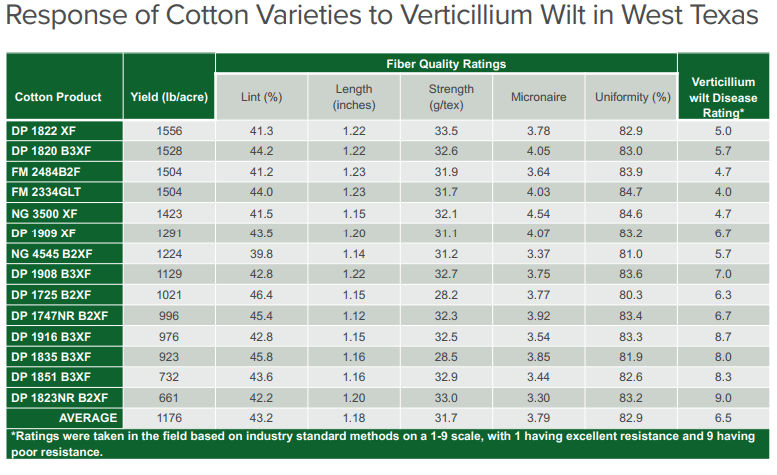3 MIN READ
Response of Cotton Varieties to Verticillium Wilt in West Texas
January 11, 2019
Trial Objective
- Verticillium wilt, caused by the soil-borne fungus Verticillium dahliae, can be a yield limiting disease in cotton grown on the High Plains of Texas.
- Incidence of the disease in cotton can also negatively impact fiber quality.
- Selecting tolerant cotton varieties is the primary option for managing Verticillium Wilt.
- Field tests were conducted for the Deltapine® brand to evaluate cotton varieties in West Texas for yield potential, fiber quality, and tolerance to diseases such as Verticillium Wilt. This information can be used to help determine how cotton varieties may fit on fields with a history of the disease.
Research Site Details

- The field test site was irrigated and has a known history of Verticillium wilt disease.
- Cotton varieties were planted at 3 to 4 seeds/ft on 40-inch rows with three replications.
Understanding the Results
- Table 1 ranks the cotton varieties by the yield produced from highest to lowest at this location.
- — DP represents Deltapine® cotton varieties from Bayer Crop Science (i.e. DP 1822 XF).
- — FM represents FiberMax® cotton varieties from BASF Corporation (FM 2484B2F and FM 2334GLT).
- — NG represents NexGen® cotton varieties from Americot® cotton seed (NG 3500 XF and NG 4545 B2XF).
- Across all varieties, the average cotton yield was 1,176 lb/acre, and the average disease rating for Verticillium wilt was 6.5 at this location. The seven cotton varieties that yielded above the average had an average disease rating of 5.2 (range of 4.0 to 6.7), and the seven cotton varieties that yielded below the average had an average disease rating of 7.7 (range of 6.3 to 9.0).
- Deltapine® cotton varieties DP 1822 XF and DP 1820 B3XF produced the highest yields at this location with Verticillium wilt disease ratings of 5.0 and 5.7, respectively. DP 1822 XF is an XtendFlex® cotton variety developed for West Texas with Verticillium wilt tolerance. DP 1820 B3XF is a Bollgard® 3 XtendFlex® cotton variety with moderate tolerance to Verticillium wilt. In comparison, DP 1823NR B2XF had the poorest Verticillium wilt disease rating of 9.0 and provided the lowest cotton yield at this location. While DP 1823NR B2XF is not particularly well-adapted to West Texas, the relative yield in this test was below what has been observed in broader testing in the region.
- For comparison purposes, the FiberMax® cotton varieties FM 2334GLT and FM 2484B2F were included as Verticillium wilt tolerant checks and had disease ratings of 4.0 and 4.7, respectively, at this location. The NexGen® cotton varieties NG 3500 XF and NG 4545 B2XF were also included as Verticillium wilt tolerant checks and had disease ratings of 4.7 and 5.7, respectively, at this location. These varieties also yielded above the average at this location.
- Fiber quality ratings are also provided but did not appear to be impacted by the Verticillium wilt disease incidence at this location.
What Does This Mean for Your Farm?
- Producers have many choices when selecting cotton varieties for Verticillium wilt-infected acres, in the latest germplasms with the latest technologies. One of the best management strategies is to select tolerant varieties.
- In fields with a history of Verticillium wilt, growers should plant varieties with good Verticillium wilt tolerance and high yield potential.
- This trial is conducted on an annual basis and will be repeated next year.
ID 190219093059
